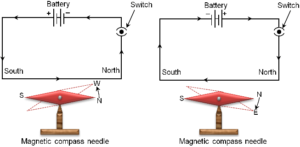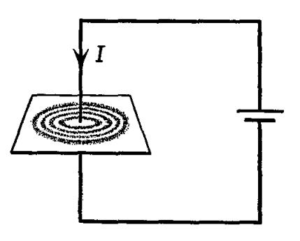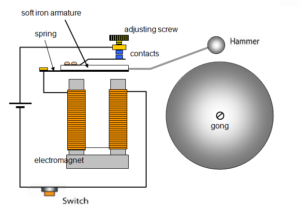Science > Physics > Magnetic Effect of Electric Current > Magnetic Effect of Electric Current
In this article, we shall study the magnetic effect of electric current and its applications.
Oersted’s Experiment:
Oersted performed an experiment to show the magnetic effect of electric current. He took long conducting wire and aligned it in magnetic meridian i.e. along the north-south direction. He put the magnetic needle exactly below the conductor. The magnetic needle aligned itself in the north-south direction such that both the conductors and the magnetic needle are parallel to each other.

When a current is passed through the conductor there was a deflection in the magnetic needle. When the current was switched off the magnetic needle came back to its original position. It shows that the magnetic field produced due to the flow of electric current. When the direction of the current has reversed the direction of the deflection of the magnetic needle also reversed. It shows that the direction of the magnetic field produced by the current in the conductor gets reversed by reversing the direction of the current through the conductor.
When the magnetic needle is put exactly above the conductor keeping the direction of the current same, the direction of the deflection of the magnetic needle was reversed.
When the distance of the magnetic needle is increased the deflection of the magnetic needle decreased. Thus the strength of a magnetic field at a point created by the current-carrying conductor depends on the distance of the point from the conductor.
Conclusions:
- Initially, the magnetic needle aligns itself in the magnetic meridian due to the action of the earth’s magnetic field on the needle. After passing a current through the conductor there is a deflection in the magnetic needle and when the current is switched off there is no deflection in the magnetic needle which indicates that due to the flow of current in conductor there is a creation of magnetic field around the conductor.
- If the direction of current is reversed deflection of the needle is also reversed which indicates that if the direction of current in the conductor is reversed there is a reversal of direction of the magnetic field around the conductor.
- The direction of the deflection of the needle depends upon the position of the needle i.e. whether it is kept above or below the conductor.
- If the conductor is aligned in the east-west direction and current is passed through it, then there is no deflection.
To Find the Direction of Deflection of Magnetic Needle:
- Swim rule: Imagine a person swimming along the wire in the direction of current with his face towards the needle, then the north pole of the needle will be deflected towards his left hand.
- Right-hand palm rule:
- Hold your right-hand palm along a conductor such that fingers are indicating the direction of current and palm facing conductor then the north pole deflects in the direction of the outstretched thumb.
Nature of Magnetic Field Due to Current in Conductor:
Plane cardboard was taken and a small hole is made at the centre. The conductor carrying current is passed through this hole. The cardboard is kept horizontal and some iron filings are spread on it. When current is passed through the conductor iron filings get adjusted in the form of concentric circles.

It means the magnetic field produced by the current-carrying conductor is in the form of concentric circles.
The Direction of Magnetic Field Due to Current in Conductor:
Right-Hand Thumb Rule or Right-Hand Grip Rule:
Hold the current-carrying conductor in your right hand such that the outstretched thumb indicates the direction of the current, then the direction of curled fingers indicate the direction of the magnetic field created by the conductor.

Right-hand Screw Rule:
Imagine that right-hand screw is held with its axis parallel to the direction of the conductor is rotated with fingers such that the tip of the screw move in the direction of the current. Then the direction in which the fingers rotate the head gives the direction of magnetic induction.

Factors Influencing the Strength of Magnetic Field:
- The magnetic field created due to current carrying straight conductor is in the form concentric circles whose direction is given by Right-hand thumb rule.
- The strength of the magnetic field depends on the current through the conductor. If the current increases, the strength of magnetic fields increases. When the current through the conductor decreases there is a decrease in the strength of the magnetic field.
- The strength of the magnetic field at a point depends on the distance of the point from the current-carrying conductor. If the distance increases the strength of the magnetic field decreases and as the distance decreases the strength of the magnetic field increases.
Electromagnets:
An electromagnet consists of a soft iron piece on which an insulated copper wire is wound. Thus it is a current-carrying coil wrapped around a piece of iron called core.

When an electric current is passed through the coil the arrangement behaves like a magnet. It is a temporary magnet because when the current through the coil is switched off, the arrangement ceases to be a magnet. The strength of electromagnets depends on the number of turns of the coil and the strength of the electric current through the coil. The strength of electromagnets increases with an increase in the number of turns of the coil and also increases with an increase in the amount of the current passed through the coil. By reversing the direction of current the position of poles of electromagnets can be altered.
The end of the coil where the direction of current anticlockwise becomes the North Pole and the end where the direction of the current clockwise becomes the South Pole. Symbolically it is shown as follows.

There are two types of electromagnets viz. a) bar magnet (The iron piece is in the form of a bar) and b) U-shaped magnet (The iron piece is in U-shaped).

Applications of Magnetic Effect of ELectric Current:
Electrical appliances such as the electric doorbell, electric fan, electric motors work on the principle of electromagnets.
- They are used in lifting heavy iron loads and iron scrap.

- They are used to remove iron particles from the wound.
- They are used in the concentration of ores using electromagnetic separation.

- They are used in the preparation of strong permanent magnets used in speakers.

- They are used in loading iron in the furnace.
- Some medical ailments can be detected and cured by electromagnets.

- The principle of electromagnetism is used in high-speed Maglev trains

Force Experienced by Current-Carrying Conductor in Magnetic Field:
The conductor carrying current when subjected to a magnetic field experiences a force. If the conductor is perpendicular to the magnetic field then the direction of the experienced force is perpendicular to both the conductor and the magnetic field. When the conductor is parallel to the magnetic field, it experiences no force.
Solenoids:
A solenoid consists of an insulated copper wire wound around a cylindrical cardboard or a soft iron core. It is similar to the electromagnet.

Electric Bell
The circuit arrangement of an electric bell is as follows

When the Push switch is pressed circuit gets completed. The current flows through the coil. It creates a U-shaped electromagnet which attracts the armature made up of magnetic material towards it. A hammer is attached to the armature. When armature moves towards the electromagnet, the hammer strikes on the gong and the bell rings. But when the armature is moving towards the electromagnet the contact with the adjustment screw breaks. Thus the current in the electromagnet stops. The iron core of electromagnet loses its magnetic properties and armature is thrown back away from the magnet due to the spring to its normal position where there is a contact again with the adjustment screw. Thus the circuit is completed. This process repeats continuously by make and break and the hammer continues to strike the gong till the push button is pressed.
Next Topic: Biot-Savart’s Law and its Applications

3 replies on “Introduction to Magnetic Effect of Electric Current”
I love this platform it’s cool
We are really appreciated
I like the how the explanations are given in a simple, understandable way.